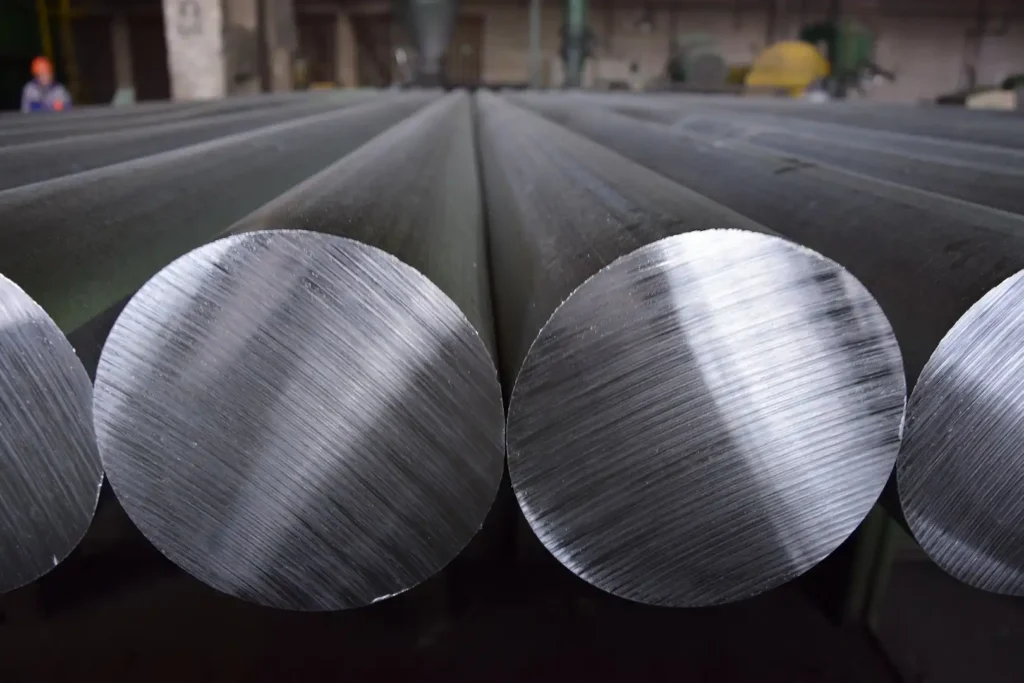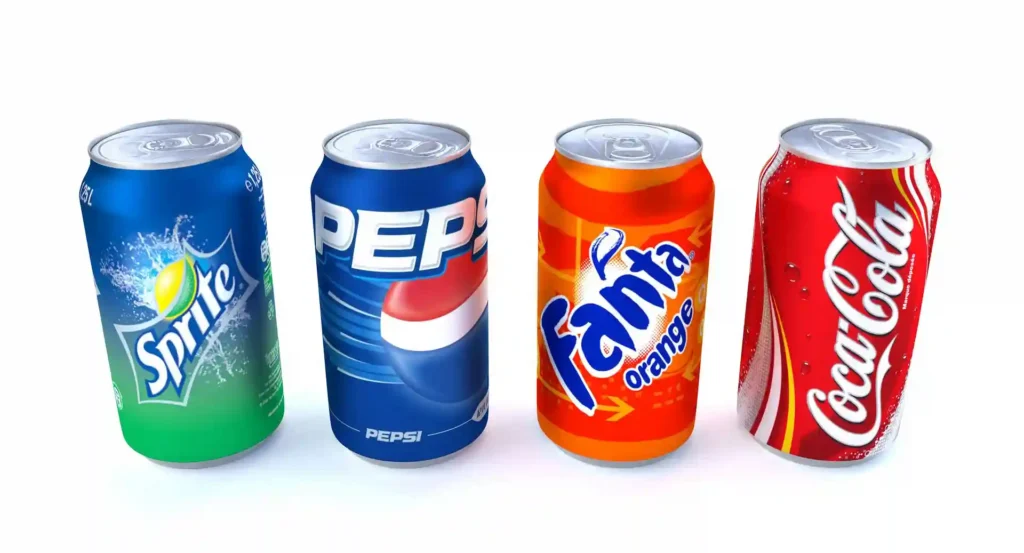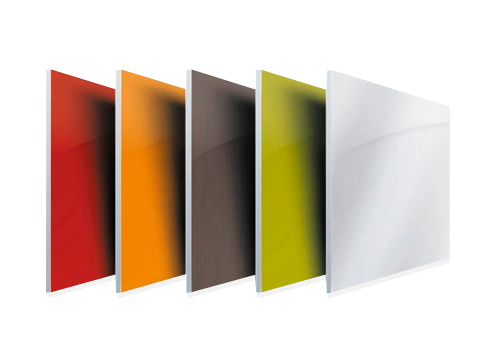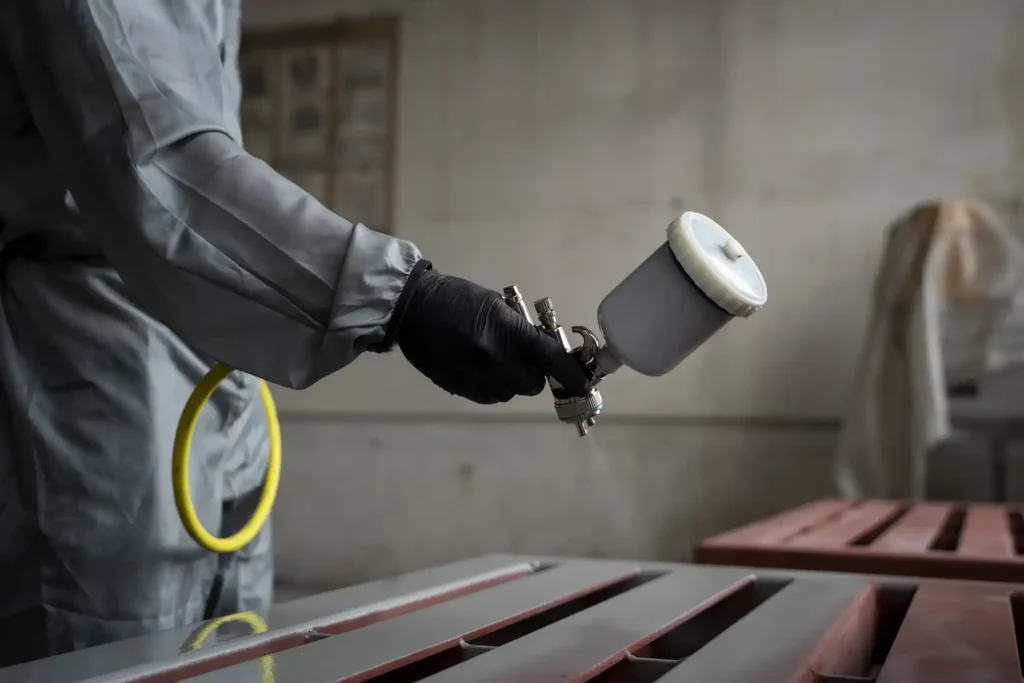
The aluminium coating is a type of protective layer that’s applied to metals to prevent corrosion. They’re commonly used in industrial settings, where they protect machinery and equipment from rusting. In addition, aluminum coatings are often used in consumer goods, such as cookware, toys, appliances, and other household items.
- What is Aluminium?
- Introduction to Aluminium.
- Properties of Aluminium.
- Production and Processing of Aluminium.
- Uses of Aluminium.
- The Future of Aluminium Usage and Production.
- Uses of aluminium in construction
- Curtain Walling.
- Roofing and Cladding.
- Structural Glazing.
- Load-Bearing Systems & Frameworks.
- Ladders, Handrails and Balustrades.
- Uses of Aluminium for roofing and cladding
- Benefits of Using Aluminium for Roofing and Cladding.
- Which type of Aluminium should use for roofing and cladding?
- About Aluminum Composite Panels (ACP)
- What Is an Aluminum Composite Panel?
- Different Sizes of ACP
- Advantages of Using ACP
- Disadvantages of using Aluminium Composite Panel (ACP) in Building
- What is the Solution to this problem?
- A Step-by-Step Guide to coating an Aluminium Composite Panel
- 1. Prepare the Surface.
- 2. Select Appropriate Primers and Sealants.
- 3. Coat ACP using Sprayers.
- 4. Wait for the First Layer to Dry and Recoat as Needed.
- What is an Aluminium Coating Service & How to Use It?
- How we can help you?
- How to Protect Aluminum Composite Panel From Corrosion
What is Aluminium?
The crust of the earth contains the element aluminium. It likewise has a lustrous appearance and is a silvery-white metal. Most of the aluminium in the world is buried in the ground. Therefore, in order to use it in our daily lives, we must mine the metal. Some nations use electromagnetic waves, which produce extreme heat and toxic gases, to extract aluminium. They then refine the aluminium so that we can use it to produce goods.

Introduction to Aluminium.
Aluminium is one of the most widely used materials in the world due to its versatility and lightweight. It has a variety of uses from industrial, automotive, and aerospace applications, to food storage and packaging, to construction projects. This guide will discuss aluminium’s properties, uses, safety considerations and more.
Properties of Aluminium.
Aluminium is a metal that is strong, light, and incredibly malleable. The Earth’s crust has a lot of this plentiful metal, which can be recycled repeatedly without deteriorating in strength or quality. Because it creates an oxide layer when exposed to air, which stops further oxidation from happening, it is corrosion-resistant. Aluminium is a good material for electronic devices like computers, mobile phones, and other gadgets because of its outstanding electrical conductivity.
Production and Processing of Aluminium.
Aluminium production starts with obtaining bauxite ore from the environment. Bauxite ore, usually found in the form of clay or rocks, is rich in aluminium hydrate and impurities such as iron oxides and silica which must be removed before the metal can be extracted. This process involves crushing and grinding the bauxite, washing and hydrolysis, alkaline digestion to dissolve alumina and filtration. The alumina is then mixed with cryolite – a mineral containing sodium aluminium fluoride – ensuring it melts at a lower temperature than pure alumina. The solution is placed in electrolytic cells, where separate electrodes are immersed into the mix. An electric current passes through the cell which creates an electrochemical reaction that separates the aluminium from oxygen in the material. This liquid aluminium is drawn off at regular intervals before being poured into moulds to create products such as cars and aerospace parts.
Uses of Aluminium.
- Aluminium is a versatile material that is widely used in various industries. It is commonly used in the manufacturing of food cans, cooking pots, and building materials due to its excellent conductivity of heat and electricity, as well as its strength-to-weight ratio. Aluminium composite panels (ACP) are a popular choice for building facades due to their durability, lightweight, and resistance to corrosion and extreme weather conditions.
- Many drinking water bottles use a layer of aluminum to keep the water fresh. The outer layer keeps external contaminants away from the bottled water. This layer also prevents the water from getting contaminated by hand contact with the bottle. After manufacturing, the bottles are coated with a layer of aluminum powder to keep them from corroding and tarnishing. Although this coating seems harsh on our environment, it’s necessary for our safety when consuming bottled water.
- If someone is wearing an aluminium coin ring, they can easily keep track of their location. These metal tokens are produced locally in the majority of nations in various weights and finishes. Each nation decides what characteristics and how to manufacture its metal token. For instance, Australia uses cast aluminium to produce its metal tokens so they won’t lose weight over time. Additionally, each token has a tinted surface finish so you can see where it starts and where it stops on your hand. Anyone looking for a simple way to keep track of their whereabouts will love these metal ring tokens.
Due to its many uses, manufacturers cover aluminium with a protective coating when making various goods for us to use every day. Coated aluminium keeps us safe when using certain products manufactured with metal material. Additionally, aluminum coins make it easy to track your belongings when placed inside your wallet or pocketbook. Hopefully, manufacturers will soon produce goods custom-made for our uses that meet our individual needs!

The Future of Aluminium Usage and Production.
With increased global demand for lightweight materials, aluminium will remain a sought-after resource and its usage and production are expected to continue rising. Additionally, new research suggests that some forms of aluminium can be recycled infinitely without losing any quality or properties – thus greatly increasing the sustainability of the metal. Finally, scientists believe that aluminium could eventually be used in biomedical devices such as implantable electronic chips and nerve stimulators due to its relative biocompatibility compared to other metals.
Uses of aluminium in construction
Due to its strength, longevity, and affordability, aluminium has grown in popularity in the construction industry. Find out more about how aluminium is used in building here!
Due to its comparatively low cost, strength, and durability, aluminium has long been a preferred material for construction applications. Aluminium has been used in construction projects all over the world more frequently in recent years because it can produce lightweight structural parts with great strength when coupled with other metals.
Curtain Walling.
Aluminium is used in curtain walling which is the exterior wall of a building that does not support any load other than its own weight. The aluminium framework allows for larger spans without the need for additional supports and offers structural strength as well as improved thermal performance compared to traditional building materials. Curtain wall construction using aluminium also provides a stylish and modern look to buildings as well as offers improved acoustic performance.
Roofing and Cladding.
Aluminium is a material commonly used for roofing and cladding in both domestic and commercial buildings due to its excellent corrosion resistance, strength as well as fire resistance. As a result, aluminium can be used in all types of environments without any risk of corroding or deteriorating quickly. In addition, it is very lightweight which makes it ideal for roofs and cladding on structures that require minimal support.
Structural Glazing.
Structural glazing is a process used in the installation of large pieces of glass to create an aesthetically pleasing and structurally strong finish. Aluminium is ideal for this purpose due to its durability and strong resistance to corrosion, making it able to withstand external weather conditions, as well as providing strength and rigidity for larger sheets of glass. As such, it’s becoming increasingly popular for use in commercial projects such as shop fronts or office buildings where slick, sophisticated design is necessary.
Load-Bearing Systems & Frameworks.
Aluminium is also a great material for building frameworks, load-bearing systems, and cladding. Its lightweight yet strong nature makes it particularly suitable for external structures where strength and durability are required. Aluminium frames offer a greater level of flexibility than other materials, like steel or wood, as they can be easily rolled or cut to fit into the design of almost any structure. This allows architects to create lighter, more precise buildings with thinner walls, creating larger interior spaces which can then be insulated more efficiently.
Ladders, Handrails and Balustrades.
Aside from cladding, load-bearing systems, and building structures, aluminium is a fantastic material. It is especially ideal for exterior projects where strength and longevity are required because to its lightweight yet sturdy nature. Compared to other materials, such as steel or wood, aluminium frames offer a higher level of flexibility because they can be simply rolled or cut to fit into the design of practically any construction. This enables architects to design structures that are lighter, more exact, and have thinner walls, resulting in interior spaces that are larger and can be insulated more effectively.
Uses of Aluminium for roofing and cladding
Aluminium is a great choice for roofing and cladding! Get tips on selecting the best type for your project, as well as advice on installation and maintenance.

Aluminium is quickly becoming a popular choice for roofing and cladding projects due to its lightweight, low maintenance, and highly durable qualities. Whether you are looking for a long-term roof or an exterior wall cladding option, aluminium has many advantages that you should consider. Learn more about the types, installation requirements, and maintenance needs of aluminium before making a decision.
Benefits of Using Aluminium for Roofing and Cladding.
Aluminium is a fantastic material for roofing and cladding projects since it is highly robust, lightweight, and corrosion-proof. Aluminium is a long-term cost-effective solution because of its great durability and low maintenance requirements. Additionally, its stylish design works well with its reflecting surface to better withstand heat transfer and safeguard against severe temperatures. Accordingly, homes with aluminium roofs are kept warmer in the winter and cooler in the summer.
Which type of Aluminium should use for roofing and cladding?
The type of aluminium that should be used for roofing and cladding largely depends on the particular requirements of your project. Aluminium Composite Panels (ACPs) are highly durable and provide excellent protection from weather elements, making them suitable for roof pitches and garages. Aluminium panels are lighter and may be more suitable for external façades, providing an aesthetically pleasing alternative to classic sheet designs. Ultimately, selecting the best type of aluminium for your project will depend on climate conditions in your area, trends in architecture, maintenance requirements, and style preferences.
About Aluminum Composite Panels (ACP)
Find out what an aluminium composite panel is and why it can be a great fit for your project. Discover the advantages, sizes, and costs associated with this high-quality material.

What Is an Aluminum Composite Panel?
ACPs are a form of flat sheet material comprised of two aluminium sheets joined together with a polyethylene core. Customers may take advantage of several advantages in terms of strength, durability, cost effectiveness, and adaptability thanks to this mix of lightweight yet robust materials. ACPs are excellent for a variety of applications including architecture, signs, and displays since they are simple to cut into any size or form. The ACP’s resilience and endurance are further increased by the addition of an aluminium coating.
Different Sizes of ACP
Aluminium composite panels come in a wide range of sizes to suit different construction needs. ACP sheets are available in standard widths of 1000mm, 1220mm and 1500mm and standard lengths of 2000mm, 2440mm, 3000mm and 4000mm. Additionally, they can be customized according to project requirements; the width range is 20-1500 mm while the length can go up to 6000 mm. However, you should keep in mind that custom orders come with extra costs.
Advantages of Using ACP
ACP is known for its strength, durability, weight-to-stiffness ratio and corrosion resistance. It is also lightweight for easy installation and maintenance, making it an ideal material for a range of applications. Moreover, due to its impermeable nature, it provides excellent protection against moisture, water and extreme weather conditions. Additionally, aluminium composite panels are fire-resistant and can withstand the force of strong winds.
Disadvantages of using Aluminium Composite Panel (ACP) in Building
- Color Fade: ACP’s colour may deteriorate with time as a result of exposure to wind, sunshine, and other environmental elements.
- Maintenance: To keep its appearance, ACP could need routine cleaning and maintenance.
What is the Solution to this problem?
1. Old technique: Replacement of ACP Panels.
Replacing old Aluminium Composite panels (ACP) with new ones can completely transform the look and feel of your building.
Disadvantages of replacement of Aluminium Composite Panel (ACP).
- Cost: Replacing ACP can be expensive, especially if the existing panel is difficult to remove.
- Labor: Replacing ACP often requires specialized skills and equipment.
- Structural Integrity: Removing the old panel and installing a new one may impact the structural integrity of the building.
- Time: Replacing ACP can be a time-consuming process.
- Environmental Impact: Discarded ACP can contribute to the waste stream and cause environmental harm.
- Compatibility: Finding a replacement panel that is compatible with the existing panel may be difficult and time-consuming.
- Permits and Approvals: Replacing ACP may require permits and approvals from local authorities.
2. Modern Technique: Spray ACP Panel Coating
The benefits of ACP recoating / Aluminium coating are:
- Cost Effective: ACP recoating is a more affordable alternative to replacing the entire ACP panel, saving building owners money.
- Improved Appearance: A new coat of paint or finish can restore the appearance of an old or damaged ACP, making it look new again.
- Customization: ACP recoating allows building owners to change the color or finish of the panel to match their desired aesthetic.
- Extended Panel Life: ACP recoating can help extend the life of the panel by protecting it from environmental damage and wear and tear.
- Energy Efficiency: ACP recoating can improve the insulation properties of the panel, reducing energy costs and improving the overall energy efficiency of the building.
- Increased Property Value: Improving the appearance and functionality of the building with ACP recoating can increase its value and make it more attractive to potential buyers or renters.
Read More: PVDF Coating on ACP Panels.
A Step-by-Step Guide to coating an Aluminium Composite Panel
Aluminium Composite Panel (ACP) recoating can extend the life of your ACP and provide added protection against the elements. In this guide, we’ll walk you through the steps to correctly recoat an ACP surface, from preparation to cleanup.
1. Prepare the Surface.
To start recoating, the ACP must be thoroughly cleaned and repaired as needed. Start by using a stiff brush to remove any dirt or debris from the surface, then use warm soapy water to clean it. If there are any existing scratches on the ACP, you can use sandpaper or an abrasive pad to fill in these imperfections before proceeding.
How to Prepare Metals for Aluminium Coating
To get the most out of your metal protective coating, it’s important to prepare the metal ahead of time. This includes abrasive cleaning the surface of any dirt and grime, as well as etching away any rust or corrosion present. Depending on the type of coating being applied, you may also need to apply a primer. After proper preparation, you will be ready to have professionals apply the metal protective coating of your choice.
2. Select Appropriate Primers and Sealants.
It’s time to choose a primer and sealant for a fresh coat of paint after the ACP surface has been prepared. ACP primers and sealants come in a variety of varieties depending on the type of finish you want. It is crucial to pick ones that can endure exposure to air and moisture and are suitable with surfaces made of aluminium composite.
3. Coat ACP using Sprayers.
Applying the primer and sealant can be done with either standard paintbrushes or sprayers. Whichever method you choose, always make sure to coat all areas of the aluminum composite panel, including corners and seams, for a uniform finish. Follow the instructions on the packaging or consult a professional in order to understand how to use each specific product correctly.
4. Wait for the First Layer to Dry and Recoat as Needed.
Once all the necessary applications have been completed. Repeat this process until all desired layers have been applied and dried, always making sure to allow each layer to dry properly before adding a second coat. Once all the layers are applied and dried, you can use a clear sealant or polyurethane finish, if desired, to further protect your Alison composite panel.
5. End with Protective Coating for Long-lasting Results.
It’s usually a good idea to give your aluminium composite panel a final protective coating for long-lasting results after you’ve applied all the necessary layers. Applying a clear sealer or polyurethane finish over the last drying layer is a wise choice. This will provide your panel additional defence against scuffs and wear and tear in general.
What is an Aluminium Coating Service & How to Use It?

Benefits of Professional Metal Protective Coating Services
Professional aluminium coating services provide an affordable option for protecting metal surfaces. The protective layer they create is durable and resilient, capable of withstanding the elements and helping to reduce wear and tear on your metal. Coating services may also help reduce confusion if you have multiple items that require protection, as it saves you time to apply one uniform coating across many pieces at once. Additionally, a professional service can ensure a clean and consistent finish on any type of metal surface.
Types of Aluminium Coating Services
Different types of aluminium coating services are available, each offering a unique set of benefits. Powder coating provides an even, wood and colour-resistant protective layer over metal surfaces. Anodizing is similar to powder coating in that it adds a protective layer but does so by further oxidizing the metal and creating a smooth surface for additional protection. Alternatively, liquid coatings can provide an even more robust layer of protection due to their thicker consistency and rapid drying time. Lastly, electroless plating adds an attractive electroplated finish on your metal surfaces without any electricity required.
How we can help you?
At Rahul Arts India, we understand the importance of maintaining the appearance and functionality of your building. That’s why we offer ACP recoating / Aluminium Coating services to help businesses and individuals revive the look of their Aluminium Composite Panels (ACP). Our experienced team is equipped with the latest tools and techniques to provide a high-quality recoating service, that meets the specific needs of your building. Whether you’re looking to restore the appearance of an old or damaged ACP, change its colour or finish, or simply improve its insulation properties, we can help. Our Aluminium recoating services are cost-effective, customizable, and designed to extend the life of your panel while also improving its appearance. We take pride in delivering exceptional results and ensuring customer satisfaction. With Rahul Arts India, you can rest assured that your building is in good hands.
Contact us today to learn more about our ACP recoating services and how we can help you bring new life to your building.
Read More: Enhancing Building Aesthetics with ACP Coatings in Delhi.
How to Protect Aluminum Composite Panel From Corrosion
Protect your aluminum composite panel from corrosion with these simple tips and tricks. Keep your panels looking great for years to come!
Aluminum composite panels are a popular choice for building exteriors due to their durability and sleek appearance. However, they can be susceptible to corrosion over time. To keep your panels looking their best, it’s important to take steps to protect them from damage. Here are some simple tips and tricks to help you maintain your aluminum composite panels and prevent corrosion.
Choose the right type of aluminum composite panel.
It’s critical to select panels that are made expressly for outdoor use and are corrosion-resistant to prevent ACP against rust. Applying a sealer or protective coating can also aid in preventing moisture and other corrosive materials from permeating the panel’s surface. There are numerous coating kinds available, such as clear, coloured, and anti-graffiti coatings. These coatings can also add an additional layer of UV protection to stop fading and discoloration.
Properly clean and maintain your panels.
The key to preventing corrosion on your aluminium composite panel is routine cleaning and maintenance. Avoid using abrasive cleansers or products that can scratch the panel’s surface and instead clean it with water and a gentle detergent. Regularly check your panels for corrosion or signs of damage, and take immediate action to stop any problems from getting worse. To add an additional layer of corrosion defence to your panels, think about sealing them with a protective coating or sealer.
Apply protective coatings.
You can make sure that your building facade stays sturdy, long-lasting, and aesthetically beautiful for years to come by choosing high-quality ACP and using a protective coating or sealer.
Avoid exposure to harsh chemicals and environments.
Avoiding subjecting your aluminium composite panel to severe chemicals and conditions is a crucial step in preventing corrosion. This entails keeping the panel away from locations with high amounts of pollution or exposure to seawater, as well as preventing contact with acids, alkalis, and other corrosive compounds. If any of these substances do get in contact with your panel, make careful to clean it completely as soon as you can to avoid damage. Corrosion may be avoided and your panel can look wonderful for many years with regular cleaning and maintenance.
Regularly inspect and repair any damage.
Regular inspection and repair of any damage is crucial to protecting your aluminum composite panel from corrosion. Even small scratches or dents can lead to corrosion if left untreated. Inspect your panel regularly for any signs of damage and address them promptly. This may include filling in scratches or dents with a protective coating or replacing damaged panels altogether. By staying on top of repairs, you can ensure that your panel stays in top condition and is protected from corrosion for years to come.
Read More: Aluminium Coating.

Is it possible to do the Aluminium Coating in Open World ?
What is the material used? Durability?
It is possible to perform aluminum coating in an open-world setting, although the specific method used will depend on the type of surface being coated.
The material used for aluminum coating is PVDF (polyvinylidene fluoride), which is sprayed onto the surface using a high-pressure air gun or similar tool.
The durability of the aluminum coating will depend on a variety of factors, including the environmental conditions to which the coated surface is exposed. Aluminum is generally a durable and corrosion-resistant material, so a well-applied coating should be long-lasting and able to withstand exposure to moisture, UV radiation, and other environmental factors. However, like any coating or surface treatment, the durability of an aluminum coating will ultimately depend on the specific application and use case.
Pingback: Painter's Tips for Painting Aluminum Windows - RAI Blog
Pingback: ACP Sheets are the most popular choice for building construction
monuments related to deep
Pingback: Everything You Need to Know About Recoating of ACP Panel
Pingback: PVDF Coating on ACP Panels - RAI Blog
Pingback: Enhancing Building Aesthetics with ACP Coatings in Delhi